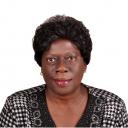
Participatory information interventions empower and inspire women to become more ambitious and invest in income-generating activities
How should we support marginalised individuals? By providing nutritional support for their body, or by supporting their mind and allowing them to see their potential? With widespread access to antiretroviral (ARV) treatment across the developing world, individuals living with HIV have the opportunity to live full and active lives. Yet, HIV-positive individuals face two main obstacles. The first one relates to the body. The medical literature shows that a poor diet can have adverse effects on the immune system of those living with HIV, and that poor nutritional status may limit the effectiveness of ARV treatments. The second obstacle relates to the mind. The stigma associated with HIV prevents individuals from achieving their ambitions and goals in life for fear of rejection (UBOS and ICF 2018).
Using information to achieve development goals
One possible barrier to overcoming these obstacles is a lack of information: information on appropriate nutrition to sustain the body and information to help overcome social stigma. Information campaigns are an important tool for correcting information failures and improving the delivery of information to poor and vulnerable groups, particularly in developing countries. Little is known, however, about whether the way information is communicated matters for outcomes or for inducing behavioural change. A number of recent studies have found using role models to be effective at inspiring changes in preferences and attitudes (Serra forthcoming, Banerjee et al. 2019, Dupas 2011), and an important mechanism through which role models lead to behavioural change is by shifting aspirations (Bernard et al. 2014, Dalton et al. 2016, Genicot and Ray 2017, Lybbert and Wydick 2018). In situations of extreme poverty, and especially for vulnerable groups such as stigmatised women living with HIV, hopelessness can prevent individuals from investing available resources to improve their situation, thus stifling economic development.
In recent work (Lubega et al. 2021), we explore ways to improve the welfare of women living with HIV, by providing information on how to address the two main obstacles that they face: obstacles in relation to the body and obstacles in relation to the mind. We explore how two different information campaigns, one that provides information on the importance of nutrition and how to fulfil nutritional needs, and the other that provides information that inspires women to improve their outcomes in a sustainable way via peer-learning and role models, can ease these obstacles and allow participants to realize their capabilities and improve their economic outcomes.
How can the welfare of women living with HIV be improved?
We designed a multifaceted randomised controlled trial involving 4,200 HIV-positive women. Participants were randomly selected from HIV-positive women attending 32 randomly selected health clinics in Uganda. Clinics were randomly assigned into three treatment groups and a control group. Over the course of a year, patients in treated clinics were invited to participate in one of three treatment arms.
The first treatment arm was a standard nutritional information campaign. This campaign (Good Nutrition for Better Health) was developed together with the Ugandan Ministry of Health and was designed to mimic a standard information campaign to promote good nutrition and healthy eating habits. The nutrition information was printed onto flyers and posters for circulation by health workers in the treated clinics. The back of each flyer included a recipe for a locally sourced homemade nutritious food developed by the project team, full of important nutrients for those on ARV treatment.
In the second treatment arm, participants received the same information campaign and were also given interactive and entertaining cookery demonstrations on how to prepare the locally-sourced home-made nutritious food. The aim of this treatment was to test whether using a participatory and interactive approach to providing the information has a different effect on outcomes than passively providing the information through a standard campaign consisting of flyers and posters.
The third treatment arm involved the screening of four short 3-minute videos of inspiring HIV-positive women, who run successful enterprises.1 Each inspiring woman began by describing her story from discovering her HIV-status to the challenges of and rewards from setting up her own business. Each video ends with a final message, which aims to communicate strongly to viewers that these achievements are possible for them too. A group discussion took place during and after the video screening. This treatment allowed us to test whether women living with HIV can overcome the internalized stigma and realize their capabilities, thus improving their economic outcomes.
Information improves nutrition, but participatory information interventions have longer-lasting effects
The nutrition information campaign and cookery demonstrations improved the nutritional intake of women and improved their overall health. Women in the nutrition information arm were 9 percentage points less likely to have been ill in the previous 30 days while those in the cookery arm were 17 percentage points less likely.
The benefits for women in the cookery clinics, however, extended beyond health outcomes. They also experienced significant increases in overall income due to working more days in self-employment, income-generating activities, and had higher levels of productivity. The nutrition information campaign had no impact on incomes illustrating that the means through which the information was delivered mattered. Indeed, we found that the interactive and participatory nature of the cookery demonstrations had an inspirational effect, made women more ambitious and inspired them to start their own enterprises leading to an increase in their overall incomes.
The role models campaign specifically targeted an inspirational channel, focusing on enterprise development. Women in this treatment arm were 12.3 percentage points more likely than the control group to run a business one year after the start of the intervention. Exposure to the role models also led to higher incomes from livestock and non-agricultural enterprises and changed the composition of income-generating activities of women, with a shift away from low-paid casual jobs towards self-employment activities. The videos and the group discussion around the videos inspired participants but also provided a training function with our results showing that the women took on the specific advice for running a business provided by the role models.
Policy implications: The mode of information provision matters
All three treatments led to the expected behavioural change among women, but those that involved a participatory component had an additional effect that inspired participants to become more ambitious, ultimately starting new economic activities and leading to higher income levels. This result is particular striking for the cookery demonstrations treatment, which was designed to provide information about nutrition, but that affected behavioural change well beyond the scope of the treatment. This suggests that while standard information campaigns can be effective in achieving desired health outcomes, a more participatory and interactive medium of delivery can play an important complementary role in translating improved health into higher incomes.
Our study speaks to the recent literature that highlights the role of peer-learning and targeted teaching in achieving results in relation to entrepreneurial training and financial decisions in developing countries (Lafortune et al. 2018, Bursztyn et al. 2014). Both the cookery demonstrations and the role models videos conveyed practical information in a peer-to-peer setting. Our results show that information about the locally-sourced foods was more likely to be used if it was provided in an interactive way. Similarly, the information the inspiring women provided in the videos was taken on board by the participants in relation to their economic activities. The message our role models portrayed was indeed inspiring but is also realistic. We show that even if role models are just marginally more successful than the participants, there can be significant effects. This suggests that role models could be used, not only as a tool for inspiring individuals, but also as an alternative to costly education and training programs which have often been found to have mixed effects on economic outcomes (Bandiera et al. 2017, de Mel et al. 2014).
Conclusion
We started with two questions: how should we support marginalised individuals? By providing nutritional support for their body or by supporting their mind and allowing them to see their potential? We show that interactive information treatments can provide support for both the body and the mind. These findings are relevant for the design of similar information-focused policies and have the potential to have longer-term effects on welfare than passive information campaigns.
References
Bandiera, O, R Burgess, R N Das, S Gulesci, I Rasul and M Sulaiman (2017), “Markets and poverty in village economies”, Quarterly Journal of Economics 132(2): 811-870.
Banerjee, A, E La Ferrara and V Orozco (2019), “The Entertaining Way to Behavioral Change: Fighting HIV with MTV”, NBER Working Paper 26096.
Bernard, T, S Dercon, K Orkin and A S Taffesse (2014), “The Future in Mind: Aspirations and Forward-Looking Behaviour in Rural Ethiopia”, CEPR Discussion Paper No. 10224.
Bursztyn, L, F Ederer, B Ferman and N Yuchtman (2014), “Understanding mechanisms underlying peer effects: Evidence from a field experiment on financial decisions”, Econometrica 82(4): 1273–1301.
Dalton, P S, S Ghosal and A Mani (2016), “Poverty and aspirations failure”, The Economic Journal 126: 165-188.
de Mel, S, D McKenzie and C Woodruff (2014), “Business training and female enterprise start-up, growth and dynamics: Experimental evidence from Sri Lanka”, Journal of Development Economics 106: 199-210.
Dupas, P (2011), “Do teenagers respond to HIV risk information? Evidence from a field experiment in Kenya”, American Economic Journal: Applied Economics 3(1): 1-34.
Genicot, G and D Ray (2017), “Aspirations and inequality”, Econometrica 85(2): 489-519.
Lafortune, J, J Ruitort and J Tessada (2018), “Role models or individual consulting: The impact of personalizing micro-entrepreneurship training”, American Economic Journal: Applied Economics 10(4): 222-245.
Lubega, P, F Nakakawa, G Narciso, C Newman, A N Kaaya, C Kityo and G A Tumuhimbise (2021), “Body and mind: Experimental evidence from women living with HIV” Journal of Development Economics, 150, 102613.
Lybbert, T J and B Wydick (2018), “Poverty, aspirations and the economics of hope”, Economic Development and Cultural Change 66(4): 709-753.
Serra, D (Forthcoming) “Role Models in Developing Countries”, in Handbook of Experimental Development Economics, edited by U Dashupta and P Maitra.
Uganda Bureau of Statistics (UBOS) and ICF (2018), Uganda Demographic and Health Survey 2016, Kampala, Uganda and Rockville, Maryland, USA: UBOS and ICF.
Endnotes
1 The videos can be accessed at the following links: https://vimeo.com/139188803; https://vimeo.com/126591023; https://vimeo.com/126597793; https://vimeo.com/126894420.







